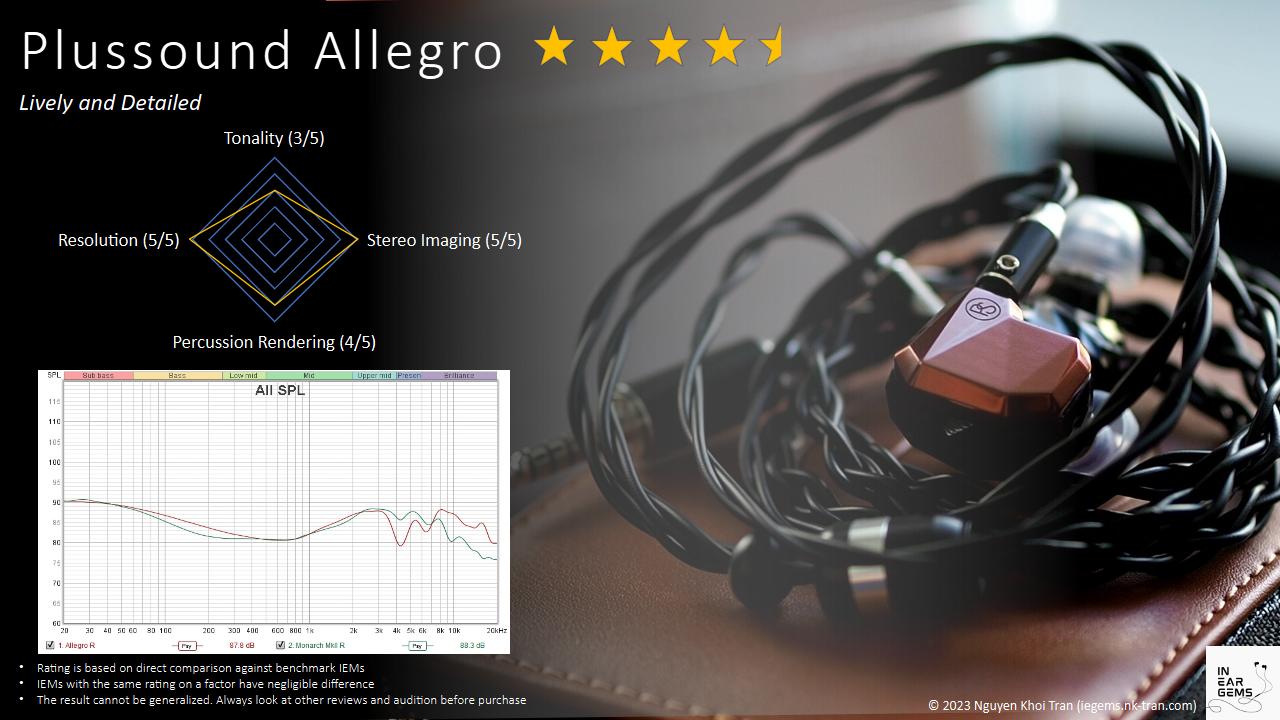Plussound Allegro - Lively and Detailed
What happen when a renowned cable maker builds IEM? Today, we are going to look at Plussound’s Allegro, a 12-driver tribrid behemoth.

Forewords
- What I look for in an IEM is immersion. I want to feel the orchestra around me, track individual instruments, and hear all of their textures and details. I’m not picky about tonality, as long as it does not get in the way of immersion.
- I rate IEMs within with a consistent scale from 1 (poor) to 3 (Adequate) to 5 (outstanding). Ratings are assigned by A/B tests against benchmark IEMs, regardless of the retail price.
- Ranking list and measurement database are on my IEM review blog.
- This review is possible thanks to the Australian tour arranged by Plussound and @Damz87 (Thank you!). I have no affiliation with or financial interest in Plussound. The unit retails for $3499 at the time this review was published. You can find out more details and grab yourself a unit from Plussound online store
Specs
- Driver: 2DD + 6BA + 4EST (6-way crossover)
- Connector Type: 2-pin 0.78
- Impedance: 10 ohms @1kHz @1mW
- Sensitivity: 112 dB @1kHz
Build and Comfort



Accessories: It should be noted that my review sample may not come with the full retail packaging. Upon opening the box, there is a plastic cover that proudly states the product is hand assembled in LA. Underneath the cover, you will find a large leather case containing the IEMs themselves, a cable, and a leather cable tie, which I did not unpack. Additionally, my review sample came with multiple sets of ear tips. Unfortunately, I had difficulty achieving a good seal with the stock silicone ear tips, so I used my own Xelastec tips throughout the review period.

Stock cable: The stock cable provided with the Allegro IEMs is similar to the one that comes with the Effect Audio Gaea. It is thick, stiff, and hard to handle (some of you might like it). Fortunately, the cable did not cause any discomfort or noise once I properly positioned the IEMs. The hardware used on the cable has excellent build quality and a luxurious appearance.

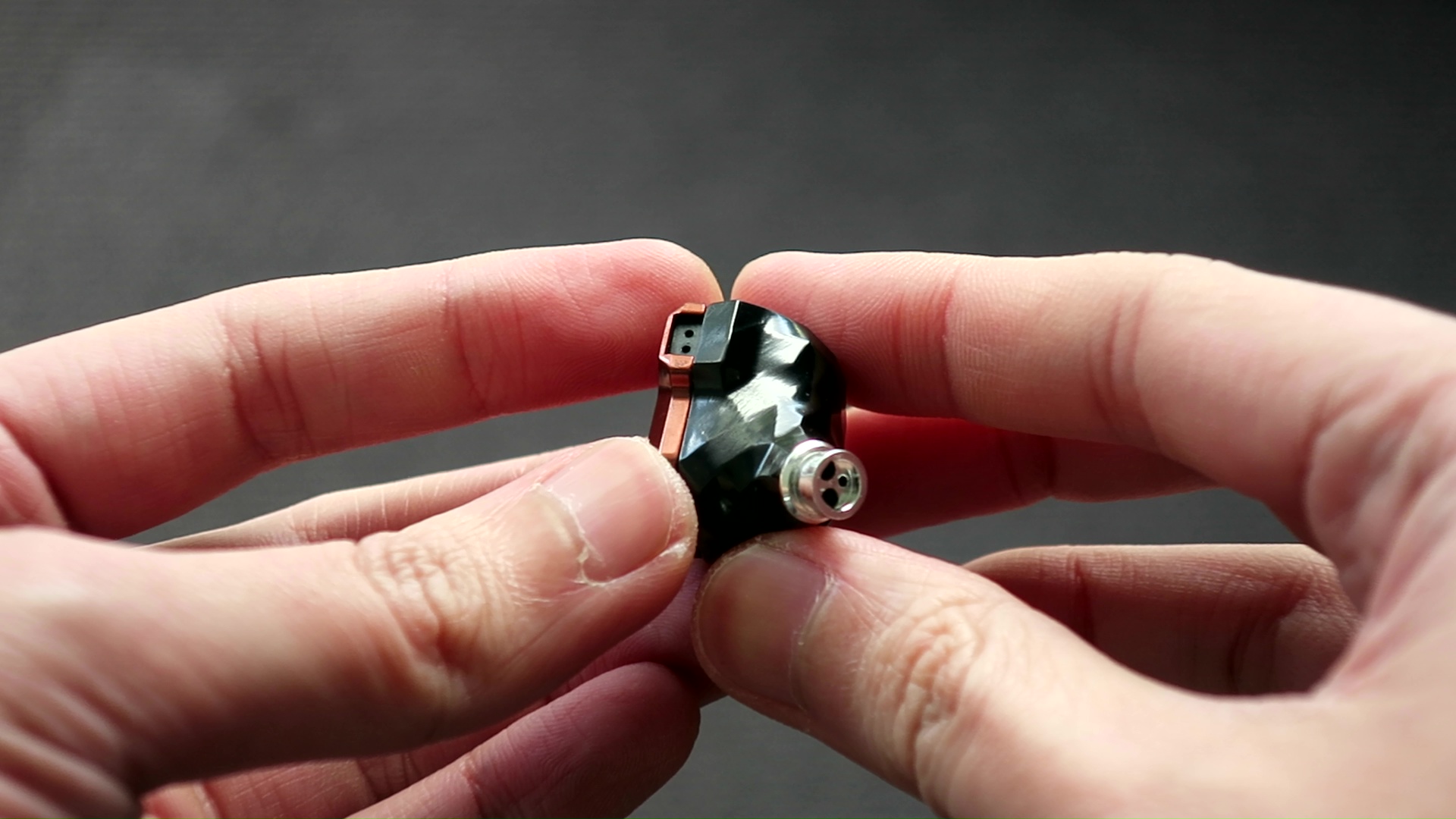


Earpieces: The earpieces of the Allegro IEMs are constructed from metal, giving them a solid feel. Initially, I mistook the black portion of the shell for plastic due to its intricate surface details. However, upon closer inspection, I discovered that this part is actually CNC-machined metal. The nozzles of the Allegro are noticeably large, and overall, the earpieces themselves are quite big and heavy. The shape of the Allegro can be likened to a pebble attached to a stick. The stick portion goes into the ear canal while the pebble portion rarely touches the ears. Due to the size of the nozzle, some eartips, such as my preferred CP145, would lose their seal after a few minutes. However, once I found suitable ear tips, namely Xelastec in my case, I found the fit and comfort to be excellent. With the right fit, the noise isolation provided by the Allegro is also quite decent.
It’s worth noting that the 2-pin connectors of the Allegro are somewhat loose, allowing the earpieces to detach from the cable if shaken. If you like to hang your IEM around your neck when moving around, don’t. You might find yourself missing an earpiece or two.
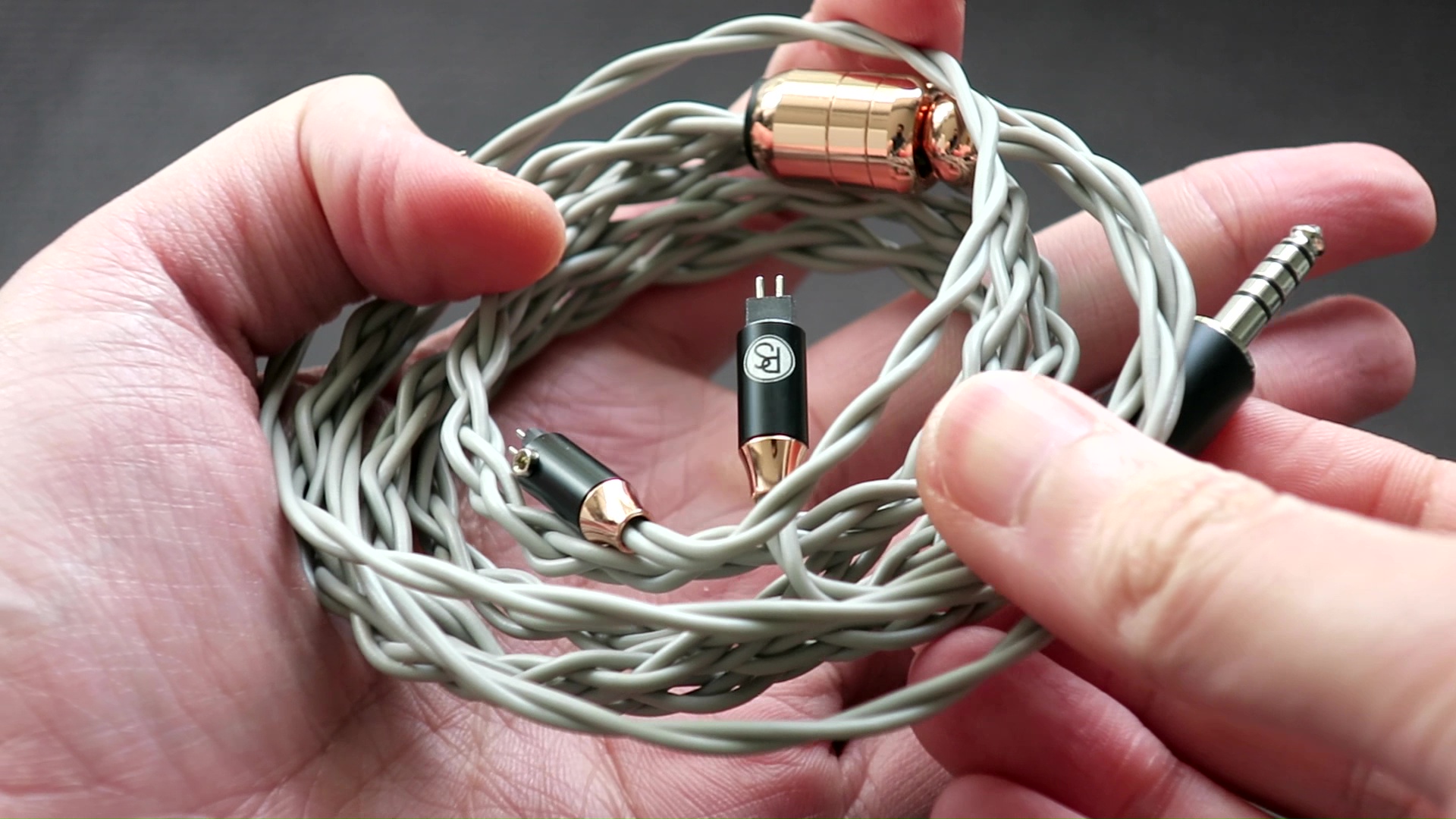

Other accessories: In addition to the aforementioned accessories, the review sample of the Allegro IEMs includes some extra goodies that are not typically included in the retail unit. Plussound, being a cable maker, provides two additional cables to showcase their collection. The cable that was attached to the Allegro when I received it was not the stock cable. I conducted a series of A/B tests in an attempt to discern any differences in sound quality. Ultimately, I found that the black cable “matches” Allegro the best by reducing a little of its upper treble. Interestingly, this black cable is actually the stock cable.

Another interesting accessory included with the review sample is a Bluetooth adapter with fancy wires. While basic in functionality, it proves to be reliable, maintaining a stable connection with my iPhone using AAC. In terms of sound, the adapter introduces a noticeable roll-off in the upper treble compared to my BTR5. This change complements the sound signature of the Allegro quite well.
Tonality
Frequency response of Allegro against the Monarch II. Measurements were done with an IEC-711-compliant coupler and might only be compared with other measurements from this same coupler. Visit my graph database for more comparisons.
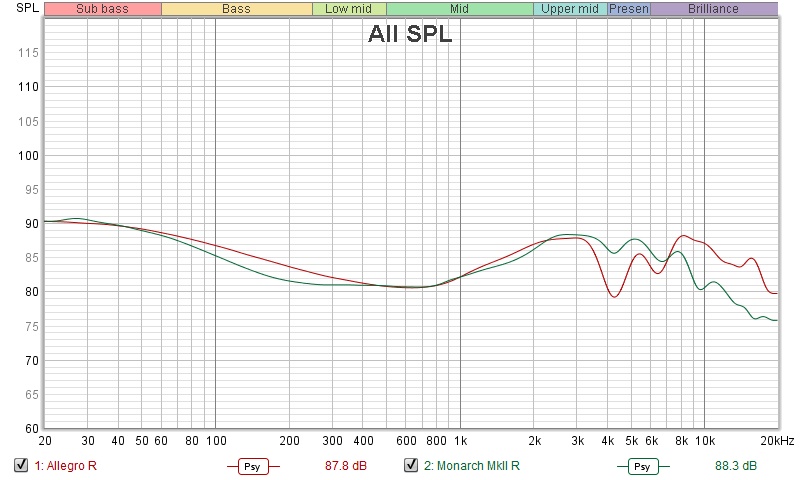
It is helpful to think of an IEM as a filter that highlights or subdues different parts of the incoming audio signal. This effect can be measured objectively by the squiggly lines above, called Frequency Response (FR) graphs, which measure how loud an IEM is at different frequencies from 20Hz (bass) to 20kHz (upper treble). Subjectivity is how your ears and brain interpret the effect of that filter on your music and decide whether it is “enjoyable.” There are some “rules of thumb” when it comes to tonality, but most interesting IEMs usually bend the rules masterfully.
The standout features of the Allegro IEMs are undoubtedly the pair of dynamic drivers (DD) acting as woofers and the four EST drivers acting as tweeters. Plussound has made sure that the presence of these drivers is hard to overlook. The most prominent aspect of the Allegro’s sound signature is the significant and sustained boost in the upper-treble. This emphasis on treble is a double-edged sword for the Allegro. The overall tonality of the Allegro can be described as bright U-shaped, with a relatively flat midrange sandwiched between boosted subbass and upper-treble.
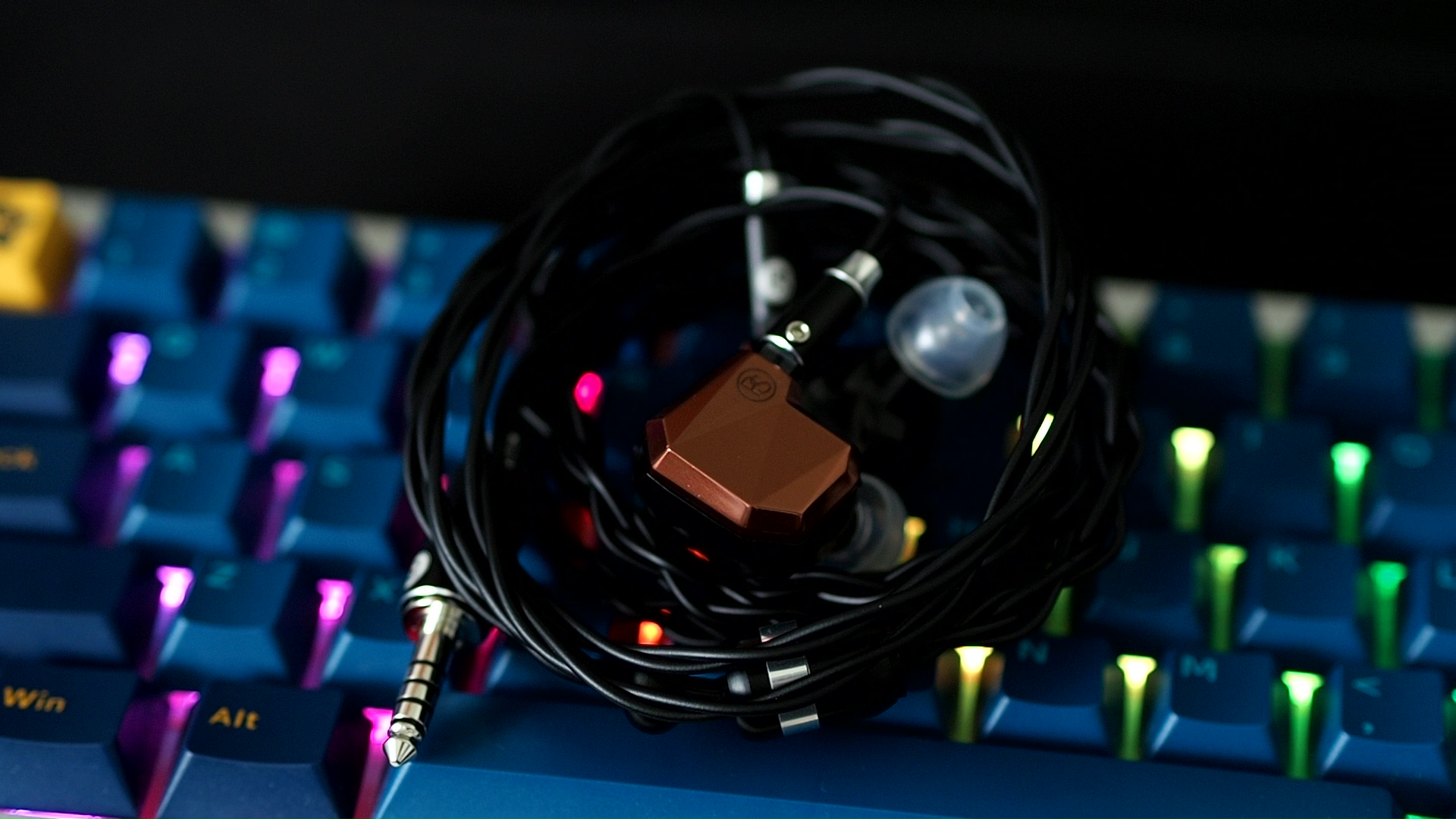
Let’s begin with the bass. The Allegro exhibits a boost in the bass above the midrange, particularly in the subbass region. This tuning gives the bass response a controlled and focused character, with a tactile feeling akin to precise jabs rather than a heavy slam. The woofers in the Allegro perform well in executing this tuning, resulting in good bass quality. The attack of bass notes is snappy and clean, and there’s a sense of bounciness expected from dynamic driver bass, rather than the crisp, almost plasticky feeling that is common with balanced armature bass.
The midrange of Allegro can be described as open and correct, without relying on excess upper midrange energy. It features a slight lift in the lower midrange to bring a touch of warmth to vocals and instruments. However, Allegro is only slightly warmer than reference, rather than a warm or coloured IEM. The upper midrange features a modest 8dB ear gain that is sustained between 2kHz and 3kHz. This “flat-top” is reminiscent of the Monarch II. This tuning choice brings vocals, especially female’s, out of the mix, but not to the point of making vocals shouty.

Now, let’s delve into the treble. First, the positive aspect: the Allegro has excellent treble extension, conveying a sense of airiness and reverb in recordings with clarity and completeness. This airiness is particularly enjoyable when listening to large orchestral pieces or live recordings.
However, there are some issues with the treble tuning. Instead of solely focusing the upper treble energy in the 15-16kHz region, Plussound chooses to emphasize the 10-12kHz region to a high degree as well. This tuning decision proves to be a double-edged sword. On one hand, it helps the Allegro achieve an unusual level of detail retrieval, bringing forth small artifacts that may go unnoticed on other IEMs. On the other hand, it imparts a metallic tint to the timbre of most instruments, occasionally making cellos sound unnatural due to this metallic timbre.
Another issue arises from the significant dip at 4kHz, further highlighting the uneven tuning of the treble region. This dip removes some texture from the music, such as the vocals in “Jolene” performed by Pentatonix. It also diminishes the energy and impact of stick strikes on cymbals and hi-hats. For instance, when listening to “Eye of the Tiger” by Survivor, I noticed that the cymbals and hi-hats sounded splashy and lacked crispness. The treble quality is not poor, but somewhat unrefined for a top-of-the-line IEM.
Soundstage Imaging

Stereo imaging or “soundstage” is a psychoacoustic illusion that different recording elements appear at various locations inside and around your head. Your brain creates based on the cues in the recording, which are enhanced or diminushed by your IEMs, your DAC, and your amplifier. Some IEMs present a wide but flat soundstage. Some present a “3D” soundstage with layering, depth, and height. In rare cases, with some specific songs, some IEMs can trick you into thinking that the sound comes from the environment (a.k.a., “holographic”)
Soundstage imaging with music (One Winged Angel by the Danish National Symphony Orchestra and Winter by Voices of Music):
The soundstage of the Allegro IEMs leans towards the larger side. It exhibits a wider rather than deeper soundstage, with the center of the stage often positioned close to the face or even within the head at times. The sense of layering within the soundstage is strong. Thanks to the Allegro’s treble extension, the outermost layers of the stage, such as the choir and the reverb, are appropriately placed with a distinct sense of distance and separation from the foreground elements, such as the rest of the orchestra. Instrument placement within the stage is sharp and precise, clearly noticeable in the opening of the Winter concerto. For example, I can discern that the violas are positioned further back in the stage compared to other instruments.
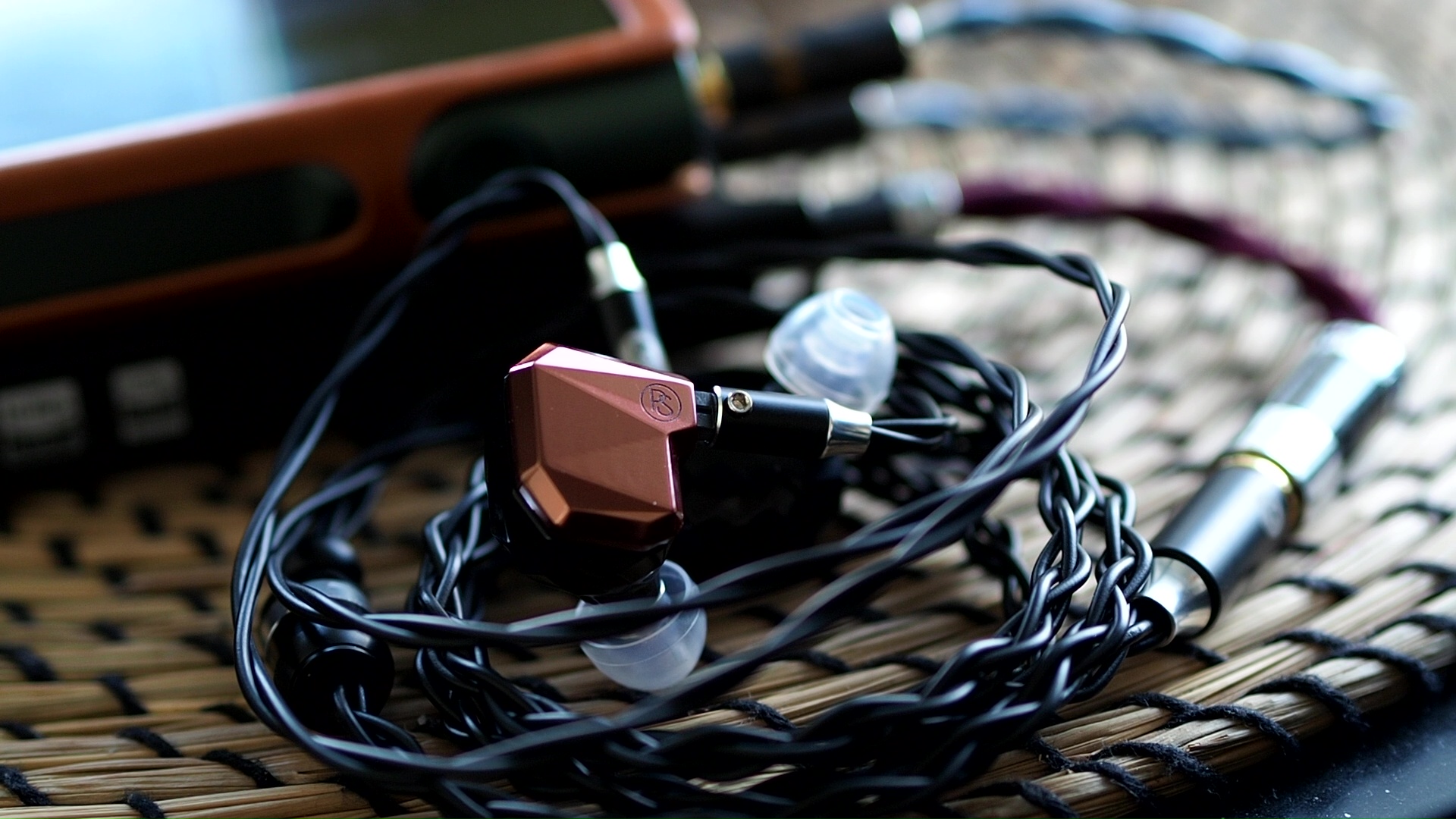
Soundstage imaging with games (CS GO Gameplay by Throneful):
The shape of the soundstage in the Allegro IEMs is wider than it is deep, which is evident during gaming sessions. However, it is remarkably easy to identify and track the direction of sounds as they move around the player. The Allegro also excels at conveying the distance and the height of sounds, allowing for accurate estimation of their position in relation to the listener.
Resolution

Resolution is a fascinating subject due to the difficulty of pinning down what it really is. To me, “resolution” can be broken down into three components: (1) Sharpness, incisiveness, or “definition” of note attacks (see the figure above). (2) The separation of instruments and vocals, especially when they overlap on the soundstage. (3) The texture and details in the decay side of the notes. The first two give music clarity and make it easy to track individual elements of a mix. The last provides music details and nuances. Smooth and well extended treble response plays a crucial role.
Clarity and Separation (One Winged Angel by the Danish National Symphony Orchestra): When it comes to clarity and separation, the Allegro IEMs exhibit a specific tuning that slightly mutes or overly smoothes the definition of note attacks, if one pays careful attention. Despite this, the overall presentation of the orchestra in the track remains crystal clear, and the individual instruments are well separated within the soundstage.

Detail retrieval (Paganini Caprice 24 by Daniel Lozakovich): Thanks to the treble tuning with emphasis around the 10-12kHz region, the Allegro excels in detail retrieval. It brings out every nuance and intricate detail, such as the sound of tapping on the fingerboard or the subtle bounces of the bow on the string. The Allegro’s ability to reveal room reverberations and decays also enhances the sense of space in recordings. However, it should be noted that the emphasis of the Allegro’s tuning can occasionally highlight distracting artifacts from certain recordings. For example, when listening to Lang Lang’s Goldberg Variations recordings, I noticed annoying clicking noises from the piano that were not audible with other IEMs, even those known for their high resolution.
Comparison and Rating

Tonality: 3/5 - Adequate
From a macro level, the tuning of Allegro is quite promising with deep bass extension, strong treble extension, a flat and open midrange, and an appropriate amount of ear gain. However, the tonality of these IEMs never quite feels completely right due to various issues in the treble region. While it remains adequate, I personally expected a bit more from a flagship-level IEM.
Percussion Rendering: Aria (3/5) < Blessing 2 (4/5) <= Allegro (4/5) < U12T / E5000 (5/5)
The bass of the Allegro lives up to its name, delivering a fast and lively performance. It offers deep bass with snappy attacks that provide a solid foundation to the overall sound. However, it may lack some excitement, as it occasionally falls short of delivering the full impact and slam that one might expect in certain bass-heavy moments.
Resolution: SE215 (3/5) < Blessing 2 (4/5) < Andromeda 2020 (4.5/5) < U12T (5/5) = Allegro (5/5)
In terms of resolution, the Allegro IEMs confidently take their place among the upper echelon of the IEM world. The Allegro’s treble tuning, although unconventional, allows it to reveal details that even the U12T might overlook. However, it is worth noting that this level of resolution can sometimes reveal recording artifacts, which can be both a blessing and a drawback.
Soundstage: SE215 (3/5) < Blessing 2 (4/5) < Andromeda 2020 (5/5) = Allegro (5/5)
Thanks to its treble extension, the Allegro IEMs boast an expansive soundstage that extends far beyond the listener. Despite having the center image positioned close to the face or even in-the-head, the Allegro manages to create a sense of space and separation between instruments. The imaging is precise, allowing for accurate placement of different elements within the soundstage.
Conclusion
The first venture of Plussound into the world of IEM is undeniably ambitious, both in terms of driver topology and price. The resulting product, Allegro, lives up to its name by delivering a lively and snappy presentation. Its technical performance is truly impressive. However, Allegro is not without its shortcomings, as it suffers from various minor tuning issues. Moving forward, if Plussound can maintain the exceptional technical performance while addressing these tuning problems, their IEMs have the potential to be truly remarkable.
Pros:
- Excellent resolution and detail retrieval
- Snappy but not wimpy bass response
- Excellent at recreating the sense of space in recordings
Cons:
- Too much upper treble around the 12kHz region
- Tonality can sound uncanny and metallic with some recordings
- Can reveal distracting recording artefacts
Who are these IEMs for:
- You value clarity and separation.
- You want to hear everything in your music.
- You like the sense of holographic staging in your music.
- You have larger ears.
